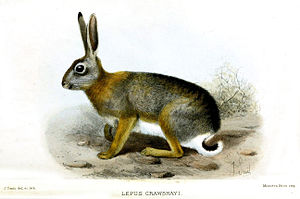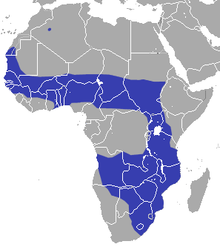Mozambique hare
| Mozambique hare | ||||||||||||
|---|---|---|---|---|---|---|---|---|---|---|---|---|

Mozambique hare ( Lepus microtis ) |
||||||||||||
| Systematics | ||||||||||||
|
||||||||||||
| Scientific name | ||||||||||||
| Lepus microtis | ||||||||||||
| Heuglin , 1865 |
The savannah or Mozambique hare ( Lepus microtis , syn .: A. L. victoriae ) is a mammal from the genus of the real hare within the hare-like species . It is distributed over large parts of Africa south of the Sahara .
features
The Mozambique hare is medium in size, weighing 1.5 to 3 kilograms, an average of around 2 kilograms. The coloring is more colorful compared to the kaphase. The back is gray-brown, the chest, sides and legs are reddish-brown, and the belly is white. In the highlands the animals are darker and more reddish than in the lowland steppes. The ears have a black tip and the tail is black on top and white on the underside. Compared to that of the kaphase, the fur is rougher.
distribution
The Mozambique hare is distributed over large parts of sub-Saharan Africa. The distribution area extends from the Atlantic coast from the territory of Western Sahara to parts of Mauritania , Senegal , Gambia and Guinea as well as the entire Sahel zone to Ethiopia and Kenya in the east and south to Namibia , Botswana and South Africa . An isolated occurrence in the area of Béni Abbès has also been described in western Algeria .
The species lives sympatric with the kaphase ( L. capensis ) in most of its range , but allopatric to parapatric with the bush hare ( L. saxatilis ) and the abyssinian hare ( L. habessinicus ).
Way of life
The Mozambique hare is nocturnal and usually lives solitary or in small groups of two or three animals. Like all rabbits, it feeds primarily on grasses and herbs, although the composition changes depending on the region and the existing vegetation. In the areas in which the habitats of the Mozambique hare and the Cape hare overlap, the Mozambique hare gives way to bushier and higher habitats while the Cape phase lives in open grasslands.
There are hardly any data or observations on reproduction. The females have young animals all year round and the litter sizes are an average of 1.6 young animals per litter and an average of 8 young animals per female and year.
Systematics
The Mozambique hare is assigned to the real hare (genus Lepus ) as an independent species . It was originally described in the past under various names ( synonyms ), including L. saxatilis , L. crawshayi , L. whytei and L. victoriae , the name Lepus microtis by Theodor von Heuglin from 1865 is the oldest and therefore taxonomically valid. In addition, the species was also listed as a subspecies of the bush hare ( L. saxatilis ) in the past .
In addition to the nominate form L. m. micotis three further subspecies distinguished: L. m. angolensis , L. m. senegalensis and L. m. whytei .
Hazard and protection
The species is classified as “least concern” by the International Union for Conservation of Nature and Natural Resources (IUCN) due to its large distribution area and high population numbers. No major threats to the species population are known, but no current data is available either.
supporting documents
- ↑ a b c d Joseph A. Chapman, John EC Flux (Ed.): Rabbits, Hares and Pikas. Status Survey and Conservation Action Plan. (PDF; 11.3 MB) International Union for Conservation of Nature and Natural Resources (IUCN), Gland 1990; P. 89 (as Lepus victoriae ). ISBN 2-8317-0019-1 .
- ↑ a b c d e f Lepus victoriae in the Red List of Threatened Species of the IUCN 2011. Posted by: Andrew T. Smith , CH Johnston, CH, 2008. Accessed November 18, 2012th
- ↑ a b c Don E. Wilson & DeeAnn M. Reeder (eds.): Lepus microtis ( Memento of the original from March 25, 2016 in the Internet Archive ) Info: The archive link was inserted automatically and has not yet been checked. Please check the original and archive link according to the instructions and then remove this notice. in Mammal Species of the World. A Taxonomic and Geographic Reference (3rd ed).
literature
- Joseph A. Chapman, John EC Flux (Eds.): Rabbits, Hares and Pikas. Status Survey and Conservation Action Plan. (PDF; 11.3 MB) International Union for Conservation of Nature and Natural Resources (IUCN), Gland 1990; P. 89 (as Lepus victoriae ). ISBN 2-8317-0019-1 .
Web links
- Lepus victoriae in the Red List of Threatened Species of the IUCN 2011. Posted by: Andrew T. Smith , CH Johnston, CH, 2008. Accessed November 18, 2012th
